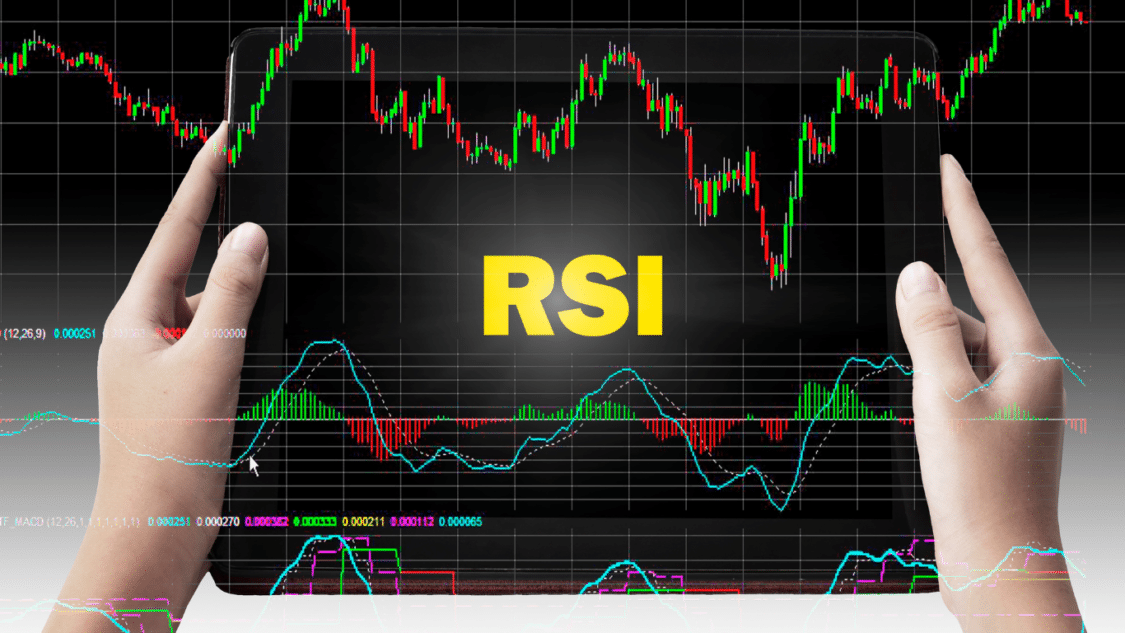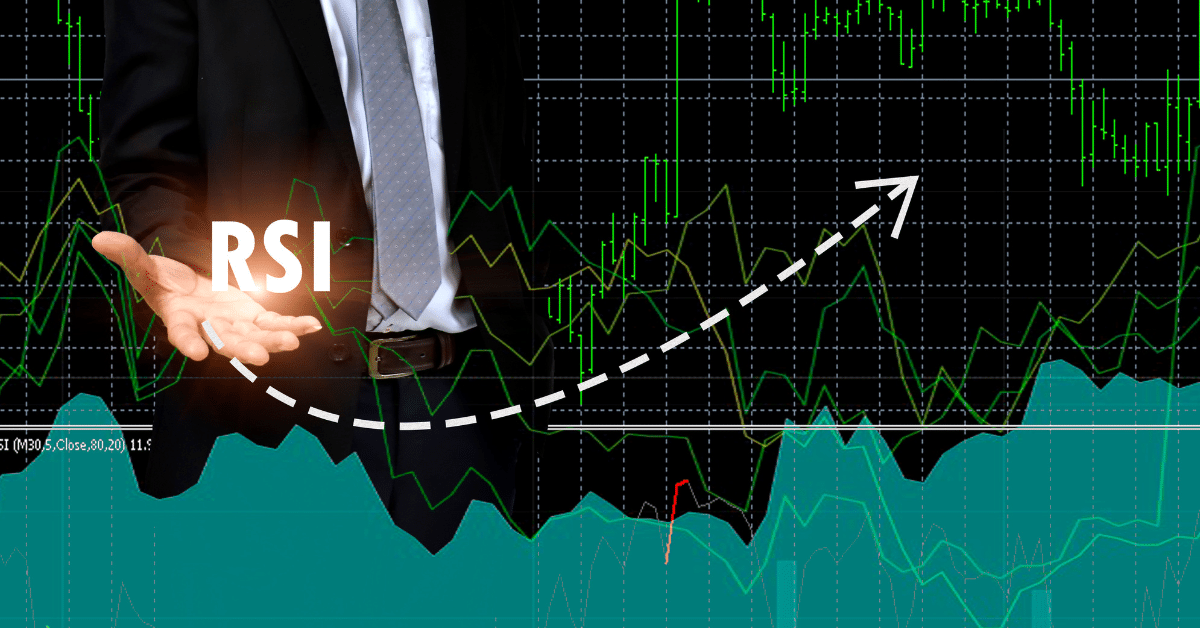- How is it calculated?
- What is the purpose of using the RSI in technical analysis?
- How is the RSI interpreted, and what are its typical signals?
- What are the limitations of the RSI, and when should it be used with caution?
- How does the RSI compare to Moving Averages or Bollinger Bands?
The relative strength index (RSI) is a technical analysis indicator that measures the strength of a stock or security’s price action. It is used to determine whether a stock is overbought (priced too high) or oversold (priced too low) and can help traders identify potential turning points in the market.
The RSI is calculated using a stock’s average gains and losses over a specified period of time, typically 14 days. The resulting value is then plotted on a scale of 0 to 100, with readings above 70 indicating an overbought market and below 30 showing an oversold market.
The RSI can be a useful tool in determining the strength of a security’s price action. However, it is recommended not to be used as the basis for making investment decisions. It should be used with other technical and fundamental analysis tools to get a complete picture of the market.
How is it calculated?

The relative strength index (RSI) is calculated using the following formula:
RSI = 100 – (100 / (1 + RS))
Where RS (Relative Strength) is calculated as the average gains over the average losses for a specified number of periods, typically 14, the average gains and losses are calculated as follows:
Average gain = Sum of gains over the last 14 periods / 14 Average loss = Sum of losses over the last 14 periods / 14
To calculate the average gain:
- Start with a specified number of periods, typically 14.
- Calculate the change in price for each period, typically using the closing prices.
- Determine if the change is positive or negative.
- If the difference is positive, add it to a running sum of gains.
- If the difference is negative, add it to a running sum of losses.
- Repeat this process for each period.
- After the final period, divide the Sum of gains by the number of periods to get the average gain.
To calculate the average loss:
- Start with a specified number of periods, typically 14.
- Calculate the change in price for each period, typically using the closing prices.
- Determine if the change is positive or negative.
- If the difference is negative, add its absolute value to a running sum of losses.
- Repeat this process for each period.
- After the final period, divide the Sum of losses by the number of periods to get the average loss.
Finally, to calculate the RSI, divide the average gain by the average loss and multiply by 100. Then subtract this value from 100 to get the final RSI value.
What is the purpose of using the RSI in technical analysis?
The purpose of using the relative strength index (RSI) in technical analysis is to help traders identify potential turning points in the market and determine whether a stock or security is overbought (priced too high) or oversold (priced too low).
RSI is based on the premise that when a security is overbought, it will likely experience selling pressure and a price decline. Conversely, when a security is oversold, it will likely experience buying pressure and a price increase. By identifying these potential turning points, traders are assisted about when to buy or sell a security.
The RSI is determined through the average gains and losses of a stock or security over a specified period of time, typically 14 days. The resulting value is then plotted on a scale of 0 to 100, with readings above 70 indicating an overbought market and readings below 30 indicating an oversold market.

How is the RSI interpreted, and what are its typical signals?
- Overbought conditions: When the RSI is above 70, it is considered overbought, which means that the security’s price has risen too quickly and could be due for a correction. This is often seen as a sell signal.
- Oversold conditions: When the RSI is below 30, it is considered oversold, which means that the security’s price has fallen too quickly and could be due for a bounce back. This is often seen as a buy signal.
- Trend strength: The RSI can also be used to determine the overall trend strength of a security. A security in a strong uptrend is likely to have an RSI reading above 50, while a security in a strong downtrend is likely to have an RSI reading below 50.
- Divergence: When the RSI is diverging from the security’s price action, it can indicate a potential trend reversal. For example, if the security is making new highs, but the RSI is failing to make new highs, it could suggest that momentum is slowing and a trend reversal is imminent.
It is important to keep in mind that the RSI should not be used as a standalone indicator and should be combined with other tools and fundamental analysis to make efficient investment decisions. Additionally, the RSI is a lagging indicator and should not be used to predict future market direction. Instead, it should be used to confirm trends and potential turning points in the market.
What are the limitations of the RSI, and when should it be used with caution?
The relative strength index (RSI) is a popular technical analysis indicator, but it also has several limitations that traders should be aware of:
- Overbought and oversold levels can be subjective: The traditional overbought level of 70 and oversold level of 30 are widely used, but these levels can vary depending on the security or market being analyzed. As a result, traders should use caution when interpreting RSI signals and adjust the overbought and oversold levels to match the specific market conditions.
- Lags behind price action: The RSI is a lagging indicator based on past price action and can be slow to signal potential turning points in the market. This means that RSI signals can be late, and the market can have already moved before the signal is generated.
- False signals: The RSI can generate false signals, especially in choppy or range-bound markets where prices move sideways instead of trending. This can lead to false overbought and oversold signals, resulting in incorrect trading decisions.
- Doesn’t account for volume: The RSI does not factor in volume, which is an essential aspect of market analysis. Security can be overbought or oversold, but if there is low volume, it may not result in a significant price move.
How does the RSI compare to Moving Averages or Bollinger Bands?

The relative strength index (RSI) is a popular technical indicator, but it is not the only one, and it can be used in conjunction with other indicators to gain a complete view of the market. Here is how the RSI compares to other popular technical indicators:
- Moving Averages: Moving averages are trend-following indicators used to level out price action and identify the overall trend. The RSI can be used with various other moving averages to confirm trend direction and potential turning points in the market. For example, a bullish crossover between the 50-day moving average and the 200-day moving average can be confirmed by an RSI reading above 50.
- Bollinger Bands: Bollinger Bands are volatility-based indicators used to pin point whether a security is overbought or oversold. The RSI and Bollinger Bands can be combined to provide a complete picture of market conditions. For example, a security trading near the upper Bollinger Band with an RSI reading above 70 could indicate an overbought market due for a correction.
- MACD (Moving Average Convergence Divergence): The MACD is a trend-following momentum indicator that can identify trends and potential buy or sell signals. The RSI and MACD can be used in combination to confirm trend direction and possible turning points in the market. For example, a bullish crossover between the MACD and its signal line can be confirmed by an RSI reading above 50.
The RSI can be a valuable tool for technical analysis. Still, it should be used with other technical indicators and fundamental analysis to make informed investment decisions. Each indicator has its strengths and weaknesses, and by combining multiple indicators, traders can get a more complete picture of market conditions and make better-informed trading decisions.
How can the RSI be combined with other indicators to form a complete trading strategy?
The relative strength index (RSI) can be a valuable tool for technical analysis. Still, it is not a standalone indicator and should be combined with other indicators and tools to form a complete trading strategy. Here are some ways to combine the RSI with other indicators:
- Trend confirmation: The RSI can be used to confirm the trend direction of security. For example, if the RSI is above 50, it suggests that the security is in an uptrend, and if the RSI is below 50, it indicates that the security is in a downtrend. This information can be combined with trend-following indicators like moving averages to provide a more complete view of market conditions.
- Overbought/oversold signals: The RSI is often used to tell if a security is overbought or oversold. By combining the RSI with momentum indicators like the Stochastic oscillator, traders can get a complete picture of market conditions and identify potential buy or sell signals.
- Support and resistance levels: The RSI can be used with support and resistance levels to determine potential entry and exit points. For example, if a security is trading near a key support level and the RSI is oversold, it could be a good entry point for a long position.
- Candlestick patterns: The RSI can be combined with candlestick patterns to identify potential reversal signals. For example, if a security is forming a bearish reversal pattern like a shooting star and the RSI is overbought, it could be a signal to sell or exit a long position.
Combining the RSI with other indicators and tools can help traders understand market conditions and make better-informed trading decisions. Traders should experiment with combinations of indicators and tools to determine what works best for their trading style and market conditions.
Can the RSI be used for trading both short-term and long-term time frames? How does the interpretation change if so?
Yes, the relative strength index (RSI) can be used for trading both short-term and long-term time frames, but the interpretation of the RSI can change based on the time frame used.
The RSI can be used for short-term trading as a quick indicator of overbought and oversold conditions. In this case, an RSI reading above 70 is considered overbought, and an RSI reading below 30 is considered oversold. Short-term traders can use these overbought and oversold levels as potential signals for entering and exiting trades.
For long-term trading, the RSI can be used as a trend-following indicator to determine the market’s overall direction. In this case, an RSI reading above 50 indicates an uptrend, and an RSI reading below 50 indicates a downtrend. Long-term traders can use this information to determine the overall trend and make investment decisions accordingly.
In conclusion, the RSI can be used for both short-term and long-term trading, but the interpretation of the RSI can change based on the time frame being used. Traders should consider their individual investment goals and market conditions when choosing a time frame for the RSI and making investment decisions.
What are some mistakes traders make when using the RSI, and how can they be avoided?

Traders make several common mistakes when using the relative strength index (RSI), and some of these mistakes can be costly. Here are some of the common mistakes made and how they can be avoided:
- Ignoring the underlying trend: The RSI is a momentum indicator but not a standalone indicator. When making investment decisions, traders should always consider the underlying trend and other technical indicators, such as moving averages and trend lines.
- Over-reliance on overbought/oversold levels: While the RSI is useful for identifying overbought and oversold conditions, these levels are not absolute. There can be instances where security remains overbought or oversold for an extended period of time. Traders should use the overbought and oversold levels as a guide, but not as a sole decision-making tool.
- Ignoring divergences: Divergences between the RSI and the security price can be an early warning sign of a potential trend reversal. Traders should be aware of these divergences and use them to confirm or refute the signals generated by the RSI.
- Not considering the time frame: The RSI is a flexible indicator that can be used in different time frames, but the interpretation of the RSI can change based on the time frame used. Traders should consider their individual investment goals and market conditions when choosing a time frame for the RSI and making investment decisions.
- Not incorporating risk management: The RSI can be a useful tool for generating buy and sell signals, but it is not a guarantee of future market conditions. Traders should always incorporate risk management strategies, such as setting stop-loss orders, when using the RSI to make investment decisions.
In conclusion, avoiding these common mistakes when using the RSI can help traders make more informed investment decisions and achieve better results. Traders should be aware of these mistakes and use the RSI as part of a well-rounded trading strategy incorporating other technical indicators, fundamental analysis, and risk management strategies.
How has the RSI performed in various market conditions? How has its popularity changed over time?
The popularity of the relative trade index has changed over time due to its versatility and ability to adapt to market conditions. The RSI has performed well in both bull and bear markets. During bull markets, the RSI can identify overbought conditions, and traders can use these signals to lock in profits or reduce their exposure. During bear markets, the RSI can identify oversold conditions, and traders can use these signals to initiate long positions or add to existing positions.
Despite its popularity, the RSI does not guarantee future market conditions. Traders need to use the RSI as part of a well-rounded trading strategy that incorporates other technical indicators, fundamental analysis, and risk management strategies.
The popularity of the RSI has changed over time due to the availability of new and more advanced technical indicators and changing market conditions. However, the RSI remains a popular and widely used indicator due to its simplicity, versatility, and ability to adapt to market conditions.
In conclusion, the RSI has performed well in different market conditions, and its popularity has changed over time, but it remains a widely used and useful technical indicator for traders. Traders should be aware of the limitations of the RSI and use it as part of a well-rounded trading strategy that incorporates other technical indicators, fundamental analysis, and risk management strategies.
Best Technical Analysis Indicators

